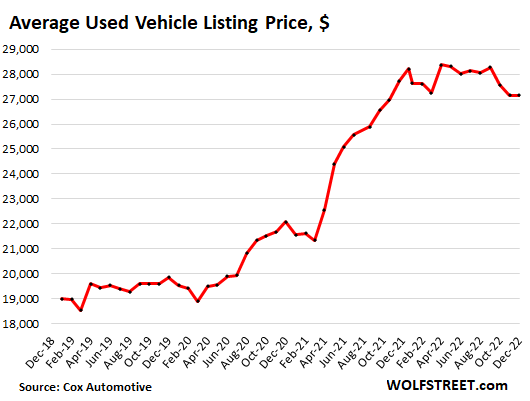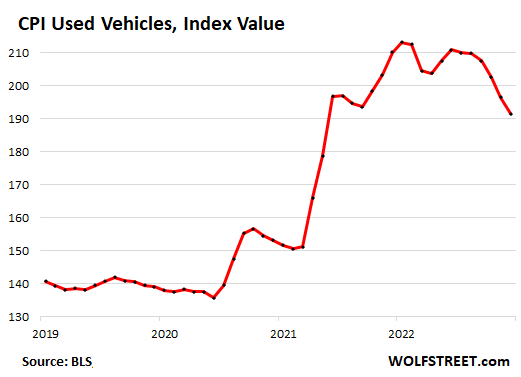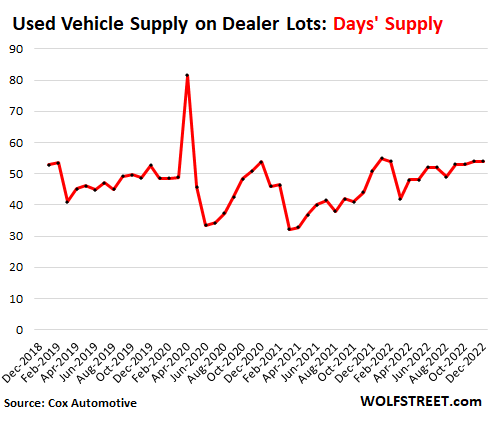January 15, 2023 | Hangover Time for Used-Vehicle Dealers. For Buyers, Patience Will Pay Off

The used-vehicle market now has a huge hangover: The price spike from August 2020 till early 2022. Over this period, retail prices spiked by mind-boggling ridiculous amounts – 40% per the average used vehicle listing price, according to Cox Automotive; 53% per the used-vehicle CPI, according to the Bureau of Labor Statistics – though there never was a shortage of used vehicles.
But now there is increasing resistance in the market against these prices, and used-vehicle retail sales in December dropped 10% year-over-year, to about 1.29 million vehicles, according to Cox Automotive.
Wholesale prices – reflecting the cost for dealers – have dropped 15% year-over-year in December, according to Manheim, the largest auto auction house and a unit of Cox Automotive.
Retail prices have dropped too, but have been stickier than wholesale prices, as dealers are trying to hold the line and slow-walk this process.
The average used-vehicle listing price dropped just 4.3% in December from the peak in April, to $27,140, roughly unchanged from November, and down 3.8% from a year ago, according the Cox Automotive. But that’s far less than the 15% drop in wholesale prices.

Just three years ago, in December 2019, the average listing price was $19,900. It’s hard to wrap your brains around these kinds of price increases. Most people can continue to drive what they already have, but that they chased after these prices in this manner is one of the big phenomena that developed during the pandemic.
And dealers made hay while they could, and bid up wholesale prices at auctions because they were confident they could sell those vehicles at even higher prices because consumers were suddenly willing to pay whatever. And prices exploded higher. But now is hangover time.
The seasonally adjusted CPI for used vehicles in December has dropped 10% from the peak in January 2022, and 9% year-over-year. It’s still less than the 15% drop in wholesale prices:

Independent dealers (such as CarMax and Carvana or the small dealer at the corner) and franchised dealers (such as Ford dealers) ended December with 2.32 million used vehicles in stock, according to Cox Automotive, which is plentiful, given the decline in sales.
At the current rate of sales, supply in December remained at 54 days, same as in November, and up from 53 days three years ago in December 2019, and up from 48 days on average in 2019:

Hangover time for used-car dealers.
During the era of the price spike, enough American used-vehicle buyers, for the first time ever, were willing to just pay whatever. Now, fewer used-vehicle buyers are willing to pay whatever, and more buyers are resisting those prices and are looking for deals, and unit sales have dropped 10% year-over-year, and dealers are having to deal with a nasty hangover.
Dealers have already dialed back their enthusiasm at the auction, and so wholesale prices plunged 15% year-over-year in December. This means that their costs of new inventory are going down. But they still have some inventory that they bought a few months ago and that is now getting stale and that they’d paid too much for. So that’s an issue they’ve got to deal with.
When dealers cut their retail prices to stimulate sales or halt the decline, their dollar-sales will go down even if unit sales stay the same. And if they cut their prices, and unit sales still decline, then their dollar sales plunge. And this is now happening.
For example, CarMax, the largest used-vehicle dealer, reported a 24% plunge in revenues in the quarter ended November 30. Its gross profit plunged 31%, and its net income plunged 86%.
Cutting prices in the face of falling unit sales is the hardest thing to do because it entails a plunge in revenues. So dealers attempt to hold the line as long as possible, which makes retail price sticky on the way down.
But prices have spiked so far, so furiously, that holding the line for long isn’t possible. In addition, interest rates have risen, and more potential buyers are resisting those prices. For buyers, patience will pay off. And for people who bought in 2021 or in 2022, well, it’s not the end of the world; their vehicle is just depreciating a lot faster than in normal times.
STAY INFORMED! Receive our Weekly Recap of thought provoking articles, podcasts, and radio delivered to your inbox for FREE! Sign up here for the HoweStreet.com Weekly Recap.
Wolf Richter January 15th, 2023
Posted In: Wolf Street











